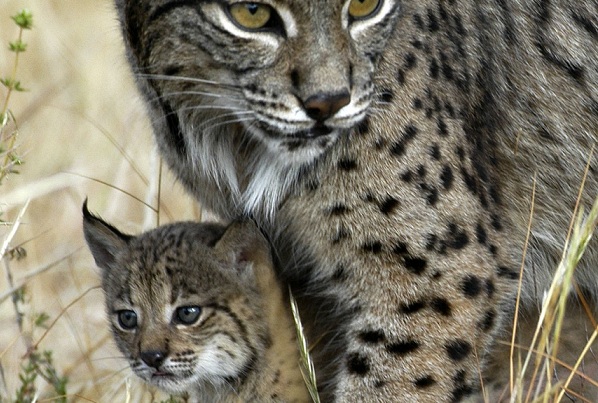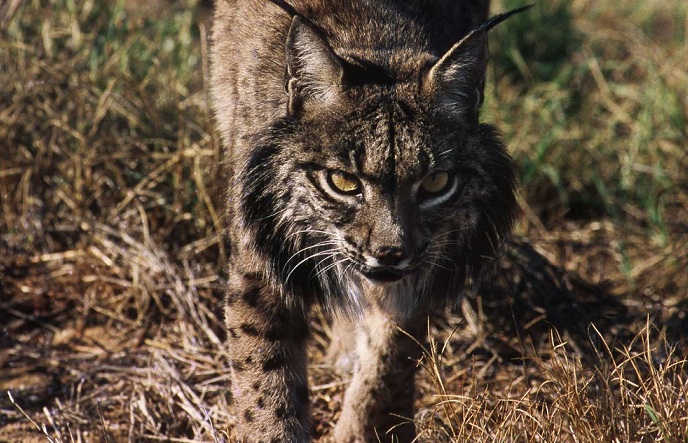The Red List | Iberian Lynx



Do you know these facts?
New born siblings of Iberian Lynx become violent towards one another between 30 and 60 days, peaking at 45 days. A kitten may even kill its siblings in such brutal fight.
In 2005, Saliega, the first Iberian Lynx to breed in captivity, gave birth to three healthy kittens at the El Acebuche Breeding Center, in the Doñana Nature Park, Spain.
The Scientific Name: Lynx pardinus
Where is it found?
This Iiberian lynx was distributed over the entire Iberian Peninsula as recently as the mid nineteenth century. It was found throughout Spain and Portugal and likely in the French Pyrenees. Numbers declined in the first half of the 20th century due to the decline of goat-herding (which helped maintain habitat for rabbit, the main food source of the Iberian lynx) and its replacement by grain cultivation. The decline accelerated in the 1950s because myxomatosis, a disease which decimated rabbit populations, spread into Spain from France, where it was introduced in 1952.
What is the population?
In 1970s, the estimated population was just couple of thousands found in isolated pockets of southern Iiberian Penninsula. By 2002, the population reduced to just 300. Despite efforts the population kept on reducing and in 2007 the figure stood at just around 100 in the wild. But after rigorous efforts by conservationists the population is slightly up now at around 200. It is now restricted to very small areas, with breeding only confirmed in two areas of Andalucía, southern Spain. The decline of the Iberian lynx in the second half of this century has been mainly due to the decline of its main prey, the rabbit , hunting and loss of the lynx’s habitat. The hunting is made illegal now. But its critical status now is mainly due to habitat loss, poisoning, road casualties, feral dogs and poaching.
How does it live?
The Iiberian Lynx is predominantly nocturnal and is an excellent tree climber. It uses a variety of locations for breeding lairs, even including old stork nests as much as 9 – 12 m above the ground. The typical gestation period is about two months; the cubs are born between March and September, with a peak of births in March and April. A litter consists of two or three kittens weighing between 200 to 250 grams. Home ranges of males and females generally do not overlap other ranges of the same sex. Male ranges overlap one or more female ranges.
Iiberian Lynx hunts mammals, birds, reptiles and amphibians at twilight, but the European rabbit is its main prey. A male requires one rabbit per day; a female bringing up cubs will eat three rabbits per day.
How does it look?
The Iiberian Lynx is a small wild cat, smaller than its relatives in the northern part of Europe, Eurasian Lynx. It weighs 9 – 13 kg (20 – 30 lb) , male being heavier and larger than the female. The head and body length is 85 to 110 centimetres (33 to 43 in), with the short tail an additional 12 to 30 centimetres (4.7 to 12 in). It has very distinctive Leopard like marks with a light grey or light brownish-yellow coat.
Conservation Efforts
Iberian Lynx has got very good attention from both government and other wildlife organizations over the past decades. In 1970, the hunting of Iberian Lynx was made illegal. Lynx became legally protected in 1973 in Spain and 1974 in Portugal. In 1996, IUCN identified Iberian Lynx as the most endangered among all the wild cat species in the world. In 2002, IUCN Cat Specialist Group initiated the first International Conference on the Conservation of the Iberian Lynx in Andujar, Spain. This brought a huge change to the conservation efforts of the species. In 2004, the Cat Specialist Group co-organized the second conference in Córdoba, Spain, in partnership with the Government of Andalusia and the WorldWide Fund for Nature (WWF). WWF has also contributed to Iberian lynx conservation through the creation and sponsorship of the Large Carnivore Initiative for Europe (LCIE). SOS Lynx is another organization that helps raising public awareness and education regarding protection of the Iberian Lynx. In the recent years, the LIFE-Lince project has been concentrating on minimizing both threats and the limiting factors in the Iberian lynx conservation. The project has been also working on the reintroduction of captive individuals into wild to strengthen wild population.
Captive breeding is another hope for the survival of the Iberian Lynx. The captive breeding program failed for initial few years, but on March 29, 2005, A Lynx named Saliega bred successfully in captivity, giving birth to three healthy kittens at the El Acebuche Breeding Center, Spain. Over these years, the Iberian Lynx captive breeding centers in Spain have created a captive breeding population of around 100 individuals, spread across three facilities. In 2009, an additional center was opened in Silves, Portugal too. In March, 2012, seven Iberian Lynx cubs were born to two adult females at this Iberian Lynx reproduction center. These are very encouraging news for the survival of the species. All these captive reproduction centers aim to reintroduce captive individuals into wild to reinforce the wild population. The first reintroductions of Iberian Lynx into a new area were carried out in December 2009 with six individuals. Though this reintroduction was not very successful as the individuals didn’t survive for more than a years in the wild, yet continued efforts have been made to reintroduce into wild. In first half of 2012, 15 individuals have been released into the wild.
A documentary on Iberian Lynx by National Geographic – Spain’s Last Lynx
13 Comments For This Post
4 Trackbacks For This Post
-
26 Gorgeous Cats That Are Disappearing From the Wild | buzzcarl Says:
August 13th, 2014 at 7:31 pm[…] relivearth.comThe Iberian Lynx is considered to be the most endangered wild cat species in the world, and is one of the rarest mammals on the planet today. A disease called myxomatosis decimated Spanish rabbit populations (the lynx’ main food source) in the 1950s. Now there are only around 100 left in the wild. […]
-
26 Gorgeous Cats That Are Disappearing From the Wild « Buzz RyanBuzz Ryan Says:
August 23rd, 2014 at 4:52 am[…] relivearth.comThe Iberian Lynx is considered to be the most endangered wild cat species in the world, and is one of the rarest mammals on the planet today. A disease called myxomatosis decimated Spanish rabbit populations (the lynx’ main food source) in the 1950s. Now there are only around 100 left in the wild. […]
-
26 Gorgeous Cats That Are Disappearing From the Wild | PASS THE KNOWLEDGE (LIGHT & LIFE) Says:
September 3rd, 2014 at 3:30 pm[…] relivearth.com – The Iberian Lynx is considered to be the most endangered wild cat species in the world, and is one of the rarest mammals on the planet today. […]
-
Disease Threats Endangered Iberian Lynx – Healthy Diet For Healthy Life Says:
September 1st, 2016 at 8:30 pm[…] Iberian Lynx – Mammal, Red List of Endangered Species … – Iberian Lynx is considered as the most endangered wild cat species and is one of the rarest mammal in the planet today. The estimated population in 2007 was just … […]
Leave a Reply
MOST CONCERNED ENDANGERED SPECIES
- Kashmir Stag (Hangul) - 229 votes
- Iberian Lynx - 154 votes
- Great Indian Bustard - 150 votes
- Long-Tailed Chinchilla - 138 votes
- Greater One Horned Rhino - 100 votes
- Orange-bellied Parrot - 95 votes
- Snow Leopard - 92 votes
- Red Panda - 82 votes
- Mekong Giant Catfish - 82 votes
- Tiger - 63 votes
-
CATEGORIES
- Amphibian (1)
- Bird (2)
- Conservation (10)
- Environment (4)
- Featured (5)
- Fish (2)
- Heavens on Earth (2)
- Mammal (11)
- Nature's Facts (8)
- Nature's Wonders (9)
- News (13)
- Red List of Endangered Species (18)
- Reptile (2)
- Wildlife (4)
-
ARCHIVES
- January 2013 (2)
- December 2012 (1)
- July 2012 (1)
- June 2012 (13)
- May 2012 (20)
- April 2012 (15)
- March 2012 (1)
- December 2011 (1)
- November 2011 (1)
- October 2011 (1)
- June 2011 (1)
- May 2011 (2)
- April 2011 (2)
- February 2011 (2)
- January 2011 (5)
- December 2010 (2)
- November 2010 (1)
- October 2010 (1)
- April 2010 (1)



 (154 votes, average: 1.00 out of 1)
(154 votes, average: 1.00 out of 1)
May 14th, 2012 at 10:10 pm
hello i am doing a research report and would like to know what else there is to the iberian lynx than this.
May 15th, 2012 at 10:18 am
Hi Faudia,
Great to know that you are researching on Iberian Lynx. You will find good materials over internet on Iberian Lynx. Quite a number of research papers are posted on internet on the species. I have also added some data on the conservation efforts of the Lynx in this page. I will be happy if these info helps you. Thanks.
-Abhijit
July 2nd, 2012 at 9:47 pm
Thanks for the sensible critique. Me & my neighbor were just preparing to do some research
about this. We got a grab a book from our area library but I think I learned more
from this post. I am very glad to see such wonderful info being shared freely
out there.
August 7th, 2012 at 8:55 am
Hi this is awesome i found all the info. i needed because at the moment i am doing my own little booklet on animals and the iberian lynx is one of them and i have asked my dad if i could start a fundraser for them
kind regards Chloe
thanks
December 9th, 2012 at 5:49 am
The Iberian Lynx is such a beautiful cat! I hope that the individuals released this year survive so their species do not go extinct. Too many animals go extinct every DAY, soon we might not have any animals left to appreciate. I’m so happy that there are organizations out there that care for our animals. If everyone in the world were like these groups, no animal will become extinct.
February 1st, 2013 at 1:19 pm
Its worth reading
February 8th, 2013 at 7:50 pm
This cat is too cute! Heehee! I wish that I could adopt them all and have a HUGE tea party with them. I’d dress them up with dresses and bows and have little kitty cat weddings!!!!!!!!!!!!!!!!!!!!!!(:(:(:(:(:(:(:(:(:(:(:(:(:(:(:(:<3<3<3<3<3<3<3<3<3<3<3<3<3<3<3<3
February 23rd, 2013 at 9:45 pm
this site was so helpful in obtaining the info needed for my report on the iberian lynx.
March 8th, 2013 at 8:37 pm
Iberian Lynx’s are just like there counterparts Eurasian Lynx. So if the Iberian Lynx interests you the Eurasian Lynx will to.
March 5th, 2014 at 8:02 pm
They are adorable! I totes agree with Jooday
March 5th, 2014 at 8:03 pm
I wanna cuddle with them!
May 13th, 2014 at 7:53 pm
Great post.
October 28th, 2016 at 12:58 pm
I am emailing you in regards to your Iberian Lynx breeding centre. I am studying a BSC Hons in Wildlife Conservation with Zoo Biology at The University of Salford andI would be extremely interested in working with the Iberian Lynx over summer. Having learned they are the most endangered cat species and yet live so close to home, I have found a new passion for these beautiful animals. If you have any contacts for me, that would be great.